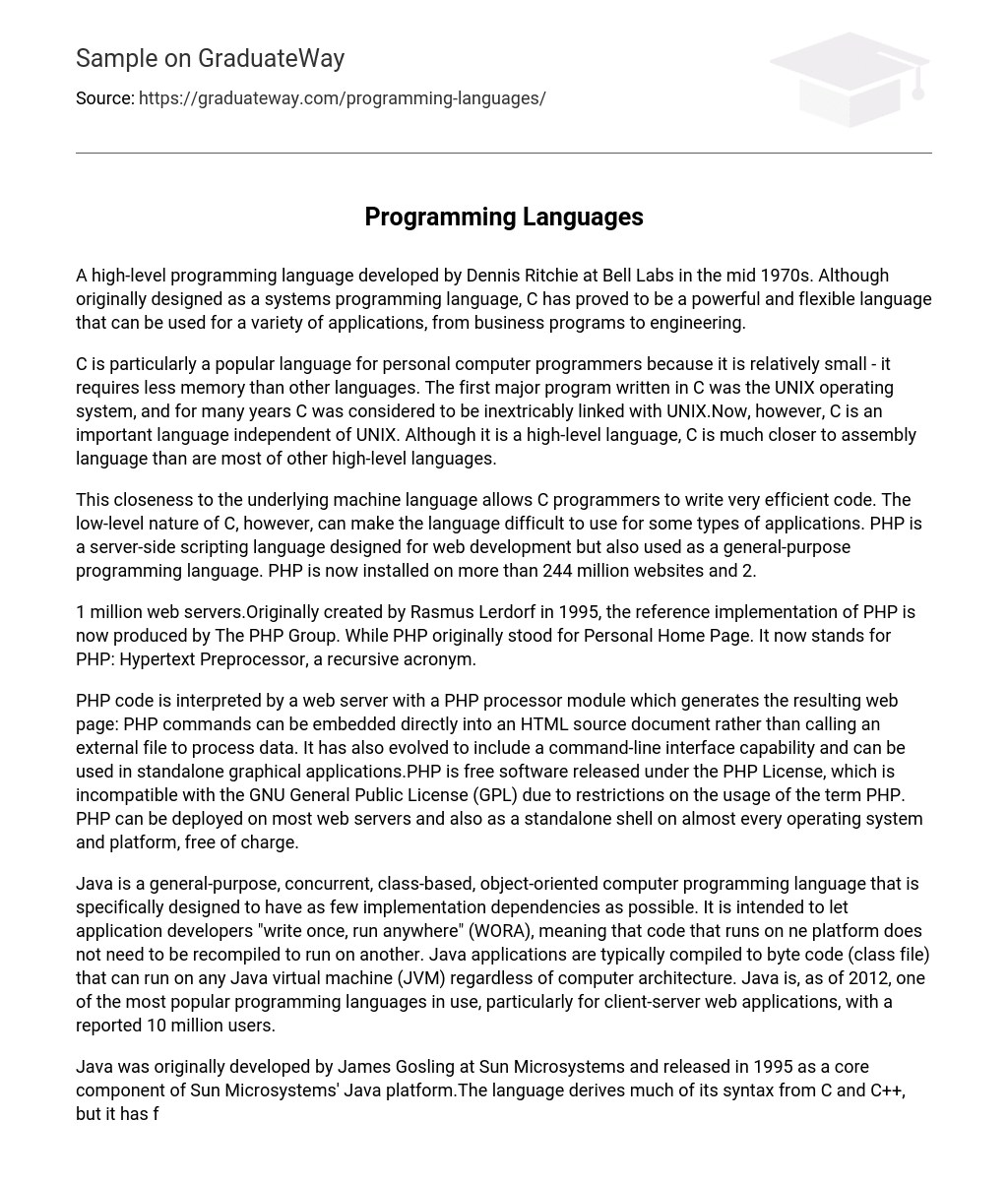A high-level programming language developed by Dennis Ritchie at Bell Labs in the mid 1970s. Although originally designed as a systems programming language, C has proved to be a powerful and flexible language that can be used for a variety of applications, from business programs to engineering.
C is particularly a popular language for personal computer programmers because it is relatively small – it requires less memory than other languages. The first major program written in C was the UNIX operating system, and for many years C was considered to be inextricably linked with UNIX.Now, however, C is an important language independent of UNIX. Although it is a high-level language, C is much closer to assembly language than are most of other high-level languages.
This closeness to the underlying machine language allows C programmers to write very efficient code. The low-level nature of C, however, can make the language difficult to use for some types of applications. PHP is a server-side scripting language designed for web development but also used as a general-purpose programming language. PHP is now installed on more than 244 million websites and 2.
1 million web servers.Originally created by Rasmus Lerdorf in 1995, the reference implementation of PHP is now produced by The PHP Group. While PHP originally stood for Personal Home Page. It now stands for PHP: Hypertext Preprocessor, a recursive acronym.
PHP code is interpreted by a web server with a PHP processor module which generates the resulting web page: PHP commands can be embedded directly into an HTML source document rather than calling an external file to process data. It has also evolved to include a command-line interface capability and can be used in standalone graphical applications.PHP is free software released under the PHP License, which is incompatible with the GNU General Public License (GPL) due to restrictions on the usage of the term PHP. PHP can be deployed on most web servers and also as a standalone shell on almost every operating system and platform, free of charge.
Java is a general-purpose, concurrent, class-based, object-oriented computer programming language that is specifically designed to have as few implementation dependencies as possible. It is intended to let application developers “write once, run anywhere” (WORA), meaning that code that runs on ne platform does not need to be recompiled to run on another. Java applications are typically compiled to byte code (class file) that can run on any Java virtual machine (JVM) regardless of computer architecture. Java is, as of 2012, one of the most popular programming languages in use, particularly for client-server web applications, with a reported 10 million users.
Java was originally developed by James Gosling at Sun Microsystems and released in 1995 as a core component of Sun Microsystems’ Java platform.The language derives much of its syntax from C and C++, but it has fewer low-level facilities than either of them. The original and reference implementation Java compilers, virtual machines, and class libraries were developed by Sun from 1991 and first released in 1995. As of May 2007, in compliance with the specifications of the Java Community Process, Sun relicensed most of its Java technologies under the GNU General Public License.
Perl is a family of high-level, general-purpose, interpreted, dynamic programming languages. The languages in this family include Perl 5 and Perl 6.Though Perl is not officially an acronym, there are various acronyms in use, such as: Practical Extraction and Reporting Language. Perl was originally developed by Larry Wall in 1987 as a general-purpose Unix scripting language to make report processing easier.
Since then, it has undergone many changes and revisions. The latest major stable revision of Perl 5 is 5. 18, released in May 2013. Perl 6, which began as a redesign of Perl 5 in 2000, eventually evolved into a separate language.
Both languages continue to be developed independently by different development teams and liberally borrow ideas from one another.The Perl languages borrow features from other programming languages including C, shell scripting (sh), AWK, and sed. They provide powerful text processing facilities without the arbitrary data-length limits of many contemporary Unix tools, facilitating easy manipulation of text files. Perl 5 gained widespread popularity in the late 1990s as a CGI scripting language, in part due to its parsing abilities.
Ruby is a dynamic, reflective, general-purpose object-oriented programming language that combines syntax inspired by Perl with Smalltalk-like features.It was also influenced by Eiffel and Lisp. Ruby was first designed and developed in the mid-1990s by Yukihiro “Matz” Matsumoto in Japan. Ruby supports multiple programming paradigms, including functional, object oriented and imperative.
It also has a dynamic type system and automatic memory management; it is therefore similar in varying respects to Smalltalk, Python, Perl, Lisp, Dylan, and CLU. The standard 1. 8. 7 implementation is written in C, as a single-pass interpreted language.
Starting with the 1. branch, and continuing with the current 2. 0 branch, YARV has been used, and will eventually supersede the slower Ruby MRI. The language specifications for Ruby were developed by the Open Standards Promotion Center of the Information-Technology Promotion Agency (a Japanese government agency) for submission to the Japanese Industrial Standards Committee and then to the International Organization for Standardization.
It was accepted as a Japanese Industrial Standard (JIS X 3017) in 2011 and an international standard (ISO/IEC 30170) in 2012.





